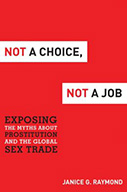Not a Choice, Not a Job: Exposing the Myths about Prostitution and the Global Sex Trade

Author: Janice G. Raymond
Publisher: Washington, DC: Potomac Books, 2013. 272p.
Reviewer: Barbara Ann Stolz | July 2014
The author, Janice G. Raymond, characterizes her book as a philosophy of feminist abolitionism — not simply a matter of theory but of strategies, practices, and policies. Specifically, she analyzes prostitution and human trafficking from a feminist abolitionism perspective and offers alternative policy and programs that address these problems in accordance with this perspective. According to the feminist abolitionism perspective, prostitution is not a choice–liberal perspective–or a moral failing–conservative perspective, but one of the final strongholds of sexualized male dominance. Before setting out her analysis of prostitution from this particular perspective, the author addresses the question of advocacy and research, noting that advocacy and academic research are usually seen as conflicting. That is, advocacy is perceived to be a threat to objectivity and researchers are expected to be neutral regarding the subject of study. Alternatively, the author argues that (1) uniting research and advocacy is a scholarly strength rather than a liability, (2) researchers should be accountable for their data and interpretations, and (3) part of the job of being a researcher is to test ideas and conclusions in the real world of programs and policy. Having cared for young women in this situation before it was called human trafficking, this reviewer understands the author’s passion and concerns for the women and girls who engage in prostitution. The tone of the book is, however, sometimes strident and criticisms of those with different opinions on the subject are sometimes personalized, which may dissuade some from reading this book. Nevertheless, the discussion of prostitution and human trafficking from a feminist abolitionism perspective contributes to our understanding of these complex social issues and, therefore, this book should be read by academics, policy makers, and lay persons concerned with these issues.
In the introduction to the book, the author sets out eight principles of feminist abolitionism, which she characterizes as basic to women’s liberation and put women’s freedom front and first. In accordance with these principles, the author sets out to expose myths about prostitution and the global sex trade, including exposing the myths about good practices promoted by the pro-prostitution lobby, not simply criticizing but also presenting alternatives. These principles include the following:
- Prostitution is not inevitable. It is constructed and can be deconstructed, not the oldest profession–pimping is, and sexual slavery.
- Regulating prostitution is based on the premise that some women can be segregated from others into a class that provides sexual services for a price and used as instruments of sexual gratification for men.
- Those who construct prostitution are the men who buy women and children for sexual activities and the pimps, brothel owners, recruiters, and other perpetrators who sell them for profit and other gain.
- Prostitution has become a global industry and requires a global solution.
- Every woman has the right to be free from sexual exploitation and not to be sold as a sexual commodity or service.
The book is organized into five chapters. In the first chapter, “Myths and Mythmakers of Prostitution,” the author identifies and examines the “central fictions” that bolster the system of prostitution and influence public opinion–what the author defines as common arguments that promote prostitution and sex trafficking and the mythmakers who invent them. The stated purpose of this chapter is to excavate these arguments; analyze them from different angles; and examine them in ways that make sense, ultimately exposing them as fiction. Among the myths identified is: prostitution is a choice. The author counters that choice has come to replace what is actually a strategy of survival for most prostituted woman. It is a “choiceless choice.” Additionally, she characterizes the distinction made between forced and free prostitution as a false dichotomy, stating that legislation that makes only forced prostitution unlawful practically guarantees that the number of indictments and prosecutions will be minimal and few women will have legal recourse and few offenders will be prosecuted if the victims need to prove that force was used to recruit them. In short, such requirements hurt the victims.
In this context, the author discusses the efforts in support of a proposed provision in the 2008 “William Wilberforce Trafficking Victims Protection Reauthorization Act,” which would have deleted the force requirement from U.S. anti-trafficking law. The Justice Department opposed this provision, as the author states, and it was not included in the final legislation. The department’s opposition was rooted in concerns regarding the effect of expanding federal responsibility for addressing pimping, pandering and prostitution. It should be noted that criminal justice in the United States traditionally has been a state and local government responsibility, with the federal role expanding primarily since the 1960s. The 2000 Trafficking Victims Protection Act was part of this expansion. Nevertheless, the lines between federal and state and local law enforcement remain generally, and in the trafficking area, specifically. Therefore, the number of federal prosecutions under the anti-trafficking laws may be low, as the author asserts. These numbers, however, do not represent the total number of federal prosecutions of traffickers, who may be prosecuted more easily under other federal offenses, or the total number of U.S. trafficking prosecutions which would include those cases prosecuted under state law. To what extent the prosecution strategy negatively affects the resources available to victims of trafficking, as suggested by the author, is an important policy question that needs to be examined in greater detail.
In chapters two through four, the author analyzes civil society’s response to prostitution. In chapter two, “Prostitution on Demand: The Prostitution Users,” the author considers prostitution users, the men who constitute the demand for prostitution. To develop a picture of the buyer, she attempts to redirect the question asked from why do the women do this to why do men do this. To answer the question of why men do this, she presents narratives from the buyers. According to the author, many countries are undecided about the legal status of prostitution users, but the situation is changing. Specifically, she describes legislation that has been passed in Nordic countries, which criminalizes the purchasing of sexual activities. The third chapter, “Prostitution Nation: The State of Prostitution in the Netherlands,” examines prostitution policy and its implementation in the Netherlands, as a model of legalized and regulated prostitution. The chapter concludes that the Netherlands demonstrates that all reasons given for how legalization would reduce trafficking, promote women’s well-being in the sex industry, control child prostitution, and neutralize organized crime have not come true. In chapter four–“Economic Development or Economic Opportunism? Trafficking, Migration, and the Military-Prostitution Complex”–the author addresses the question of why certain governments are dependent on institutionalizing a prostitution economy to increase a county’s commercial development. She argues that rather than to protect women, the aim of the legalization and decriminalization of prostitution by some governments is to profit from the growing revenues of the sex sector by capturing it within the state’s taxation net; demands for prostitution do not decline during recessions. The author challenges the position that prostitution is just another business, underscoring that the majority of those in prostitutions come from marginalized groups with a history of sexual abuse, drug and alcohol dependence, poverty or financial hardship, lack of education, and histories of other vulnerabilities. The chapter also discusses the migration-human trafficking debate, asserting that equating trafficking and migration is fraught with problems, especially the treating of trafficked persons as criminal.
The fifth chapter, “Good Practices for the Future,” considers the overarching theme of the necessity to address both innovative policies and programs to combat globalized sex trafficking and prostitution so that band-aids are not simply applied to problems. The author proposes not only to expose the myths about alleged good practices and policies to prevent human trafficking promoted by reputable United Nations (UN) programs and the prostitution lobby, but also to present alternatives. She states that most of these good practices of the UN organizations and programs have not addressed trafficking as global prostitution. Alternatively, she presents good practices that challenge the normalization of prostitution as work and confront the demand for prostitution that promotes trafficking for sexual exploitation. Specifically, she describes a number of organizations that advocate this alternative perspective and programs that have been implemented in the United States and abroad. These initiatives include the Coalition against Trafficking in Women’s (CATW) international campaign to challenge international demand for prostitution, anti-demand programs in Nordic countries, and service programs for women in prostitution in Glasgow Scotland and Ireland.
The overall strength of this book is its presentation of the feminist abolitionism perspective and application to the analysis of the problems of prostitution and human trafficking. This analysis and the policy proposals stemming from this analysis differ from those of other authors and some organizations in the field. By comparing and contrasting these differences, for example, the differing views regarding the inclusion of the “force, fraud, or coercion” requirement in U.S. anti-trafficking law, the book contributes to our understanding of the highly politicized debate on prostitution and human trafficking policies internationally and in the United States. Furthermore, by drawing attention to the limitations of U.S. federal anti-trafficking law in combating prostitution, the book also contributes to the policy discussion by raising questions about the impact of existing policies on women in prostitution and victims of human trafficking. These questions need to be considered to ensure that federal laws are addressing the needs of these women and girls effectively. Additionally, although the use of subjects as informants always presents challenges, the narratives of the buyers and the women provide interesting insights and a unique perspective and are an important contribution to the study of prostitution and trafficking. Finally, the book provides the reader with information on alternatives to current policies and describes programs that might further efforts to address human trafficking. In conclusion, this reviewer recommends this book to academics, policy makers, and lay persons concerned with the issues of prostitution and human trafficking.
Barbara Ann Stolz, independent researcher


